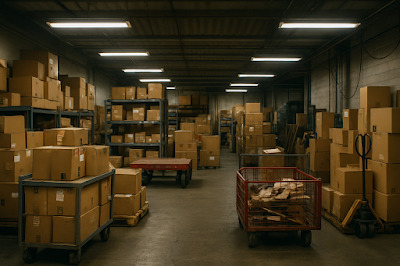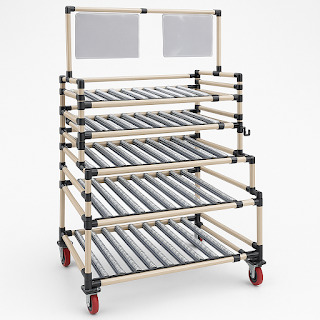#WarehouseLayout
Explore tagged Tumblr posts
Text
🏭 Top 5 Warehouse Layout Mistakes – and How to Fix Them

Introduction
A poorly planned warehouse layout can cost your business time, money, and productivity. From blocked aisles to inefficient storage zones, small mistakes in warehouse design can create big operational problems. Whether you're setting up a new space or reviewing your current setup, understanding these common mistakes—and how to fix them—can lead to smoother workflows and better space utilization.
Mistake 1: Ignoring Workflow Efficiency
Problem: Many warehouses are designed without considering how materials, people, and machines move throughout the space. This causes unnecessary travel time, delays, and confusion.
Fix: Map out your workflow—from receiving to storage, picking, packing, and shipping. Arrange departments in a logical flow that reduces backtracking. Use visual mapping tools or spaghetti diagrams to find movement bottlenecks.
Mistake 2: Poor Space Utilization
Problem: Too much unused vertical space or crammed floor areas. Either you're not using racking systems well, or aisles are too narrow for forklifts and workers.
Fix: Maximize vertical storage with tall racking systems. Use modular shelving, mezzanine floors, or pipe joint trolleys for dynamic space-saving. Keep aisle widths suitable for your equipment's turning radius.

Mistake 3: One-Size-Fits-All Storage
Problem: Using the same type of shelving or storage for every item—no matter the size, weight, or picking frequency—slows down operations.
Fix: Categorize your inventory (fast-moving, slow-moving, heavy, fragile). Use a mix of storage systems like FIFO racks, bin shelving, and mobile trolleys tailored to product needs.

Mistake 4: No Defined Zones
Problem: When receiving, packing, or dispatch zones overlap, it causes confusion, congestion, and errors.
Fix: Create clearly marked zones for each task: Receiving, Quality Check, Storage, Picking, Packing, and Dispatch. Use color-coded floor tape, signages, or flexible dividers to organize and separate each zone.
Mistake 5: Not Planning for Growth
Problem: Many businesses design their warehouse for the present load, with no plan for future expansion.
Fix: Design your layout to scale with your business. Choose modular equipment and storage solutions that are easy to move or expand, like pipe-joint systems, mobile racks, and stackable bins.
Final Thoughts
Your warehouse layout isn't just about shelves—it's about efficiency, safety, and scalability. By avoiding these 5 common mistakes and implementing smart fixes, you’ll make your warehouse smoother, safer, and more productive.
🔧 Need help designing or upgrading your warehouse? Technovision Engineers Pvt. Ltd. can help you choose the right trolleys, racks, and modular storage solutions to match your needs.
Contact Us 📍 Gat No. 1559-1560, Dehu Alandi Road, Shelarvasti, Chikhali, Pune – 412114, India 📞 +91 77740 20056 / +91 89561 62925 📧 [email protected] 🌐 www.technovisionengrs.com
#WarehouseLayout#LogisticsSolutions#IndustrialStorage#MaterialHandling#SupplyChainManagement#WarehouseEfficiency#ModularStorage
0 notes
Text
Maximizing Warehouse Efficiency: Strategic Positioning of Material Handling Equipment
Warehouse efficiency isn't just a day-to-day goal in this competitive business environment—it's a key competitive advantage. While most facility managers are focused on replacing equipment or implementing new software programs, the best and most underused tactic may be strategic positioning of material handling equipment. How and where you place your forklifts, pallet jacks, and other gear can make an enormous difference in productivity, safety, and your bottom line.

The Hidden Costs of Suboptimal Equipment Placement
If material handling equipment is installed where access is difficult, the ramifications are far more extensive than mere aggravations. Turn to these ramifications:
- More travel time: Employees traveling long distances to locate equipment translates directly into wasted production time.
- More energy consumption: Equipment idling or unnecessary traversing of the facility wastes fuel and battery life.
- More maintenance cost: Excess movement subjects equipment to greater wear and tear.
- Inefficient use of space: Equipment improperly located can preclude useful storage or working areas.
- Safety risks: Inappropriately located equipment can create risks and increase the potential for accidents.
It's possible for an average-sized warehouse to waste thousands of productive hours annually simply due to inefficient equipment placement. Let's examine how strategic positioning can transform these issues into benefits.
Key Principles for Strategic Equipment Placement
1. Activity-Based Positioning
The rule of thumb for equipment placement is to put resources where they're needed most. This involves understanding your operation's workflow patterns:
- Position forklifts near high-picking volumes or receiving docks with high volumes of heavy loads
- Position pallet jacks in areas of frequent light-to-medium load movement
- Position specialized equipment (reach trucks, order pickers) in their primary places of use
- Designate creating certain "home bases" for gear in the locations that it is utilized most frequently.
Best-functioning warehouses use an area-based equipment allocation system where each working zone will have adequate equipment readily available without redundancy.
2. Traffic Flow Analysis
It is extremely vital to be aware of movement patterns throughout your facility for optimal positioning:
- Map primary travel routes for equipment and individuals
- Identify high-traffic areas and bottlenecks
- Position equipment to minimize cross-traffic and collision risks
- Position equipment paths away from pedestrian paths wherever feasible.
Detailed traffic flow analysis typically reveals the shocking inefficiencies that can often be resolved by smart equipment relocation, in most instances, obviating the need to purchase more equipment.
3. Factors to Do with Charging and Maintenance
For electric-drive equipment, charging station locations need thoughtful consideration:
- Position charging areas close to natural break points in daily workstreams
- Don't place charging points in prime operating area
- Have distributed charging points rather than one location
- Have adequate ventilation and safety clearances around charging locations
Similarly, maintenance areas need to be placed so as to minimize equipment downtime and travel distance for servicing regular needs.
4. Seasonal and Operational Variability
Warehouse operations are not uniform throughout the year. Strategic location of equipment must take into account:
- Seasonal variation in volume
- Special promotion seasons
- Inventory profile fluctuations
- New product launches
The most effective operations create a variety of equipment placement solutions to meet these differences, with defined guidelines for switching between them as business requirements change.
Optimal Placement Implementation Strategies
Begin with Data, prior to rearranging your equipment, collect quantitative data to guide your decisions:
- Monitor equipment use rates by zone
- Measure operators' average travel distances
- Review pick density maps to find high-activity zones
- Review area-specific safety issues from accident reports
This evidence-based approach does not rely on assumption or past operating practices to make decisions.
Pilot Program Approach
Rather than changing an entire facility at one time, attempt to phase it in:
1. Select a starting point for optimizing one zone or process
2. Specify clear success criteria
3. Adjust equipment placement
4. Assess outcome after 30-60 days
5. Iterate from results
6. Roll out to additional zones
This method allows for continuous improvement and minimizes disruption to existing operations.
Equipment Tracking and Accountability
Even a well-designed placement plan fails in the absence of strict adherence. Consider implementing:
- Visual management systems (floor marking, signage)
- Equipment check-in/check-out procedures
- Operator responsibility systems
- Continual auditing of equipment location
- Measurements of performance based on proper equipment return and location.
Some operations have successfully implemented RFID or GPS tracking systems to monitor equipment location in real-time, allowing constant optimization of placement strategies.
Real-World Results
All organizations employing strategic equipment placement report consistent results:
- 15-20% reduction in non-productive travel time
- 10-15% reduction in fuel/power consumption on equipment
- Reduced equipment fleet requirements
- Reduced safety incidents related to equipment movement
- Improved utilization of space throughout the facility
- Improved operator satisfaction and reduced fatigue
One of the Midwest's largest warehouse distribution centers recently reported more than $175,000 per year in cost savings following a comprehensive equipment placement optimization, with ROI within four months.
Beyond Equipment: The Complete Approach
Strategic equipment placement is an effective tool, but it is most valuable when accompanied by complementary methods:
- Ideal slotting and inventory positioning
- Efficient pick path design
- Accurate selection of equipment for specific tasks
- Comprehensively integrated operator training
- Regular readjustment and review of placement plans as operations evolve
Conclusion
Strategic placement of equipment is one of the most cost-effective methods for enhancing the productivity of a warehouse. Unlike many improvement initiatives that entail significant capital outlays, equipment placement optimization is often budget-neutral but delivers dramatic and rapid returns.
By applying data-driven placement methods, tracking performance, and regularly refining your approach, you can convert equipment placement into a powerful weapon of competitive gain. The result is a more efficient, safer, and more profitable operation—all validating that location, in warehouse management, does indeed matter.
#WarehouseEfficiency#MaterialHandling#LogisticsOptimization#WarehouseManagement#SupplyChain#WarehouseLayout
0 notes
Link
0 notes